Tim Kraska
Steve
KramaBench: A Benchmark for AI Systems on Data-to-Insight Pipelines over Data Lakes
Jun 06, 2025Abstract:Constructing real-world data-to-insight pipelines often involves data extraction from data lakes, data integration across heterogeneous data sources, and diverse operations from data cleaning to analysis. The design and implementation of data science pipelines require domain knowledge, technical expertise, and even project-specific insights. AI systems have shown remarkable reasoning, coding, and understanding capabilities. However, it remains unclear to what extent these capabilities translate into successful design and execution of such complex pipelines. We introduce KRAMABENCH: a benchmark composed of 104 manually-curated real-world data science pipelines spanning 1700 data files from 24 data sources in 6 different domains. We show that these pipelines test the end-to-end capabilities of AI systems on data processing, requiring data discovery, wrangling and cleaning, efficient processing, statistical reasoning, and orchestrating data processing steps given a high-level task. Our evaluation tests 5 general models and 3 code generation models using our reference framework, DS-GURU, which instructs the AI model to decompose a question into a sequence of subtasks, reason through each step, and synthesize Python code that implements the proposed design. Our results on KRAMABENCH show that, although the models are sufficiently capable of solving well-specified data science code generation tasks, when extensive data processing and domain knowledge are required to construct real-world data science pipelines, existing out-of-box models fall short. Progress on KramaBench represents crucial steps towards developing autonomous data science agents for real-world applications. Our code, reference framework, and data are available at https://github.com/mitdbg/KramaBench.
SQLens: An End-to-End Framework for Error Detection and Correction in Text-to-SQL
Jun 04, 2025Abstract:Text-to-SQL systems translate natural language (NL) questions into SQL queries, enabling non-technical users to interact with structured data. While large language models (LLMs) have shown promising results on the text-to-SQL task, they often produce semantically incorrect yet syntactically valid queries, with limited insight into their reliability. We propose SQLens, an end-to-end framework for fine-grained detection and correction of semantic errors in LLM-generated SQL. SQLens integrates error signals from both the underlying database and the LLM to identify potential semantic errors within SQL clauses. It further leverages these signals to guide query correction. Empirical results on two public benchmarks show that SQLens outperforms the best LLM-based self-evaluation method by 25.78% in F1 for error detection, and improves execution accuracy of out-of-the-box text-to-SQL systems by up to 20%.
TailorSQL: An NL2SQL System Tailored to Your Query Workload
May 29, 2025Abstract:NL2SQL (natural language to SQL) translates natural language questions into SQL queries, thereby making structured data accessible to non-technical users, serving as the foundation for intelligent data applications. State-of-the-art NL2SQL techniques typically perform translation by retrieving database-specific information, such as the database schema, and invoking a pre-trained large language model (LLM) using the question and retrieved information to generate the SQL query. However, existing NL2SQL techniques miss a key opportunity which is present in real-world settings: NL2SQL is typically applied on existing databases which have already served many SQL queries in the past. The past query workload implicitly contains information which is helpful for accurate NL2SQL translation and is not apparent from the database schema alone, such as common join paths and the semantics of obscurely-named tables and columns. We introduce TailorSQL, a NL2SQL system that takes advantage of information in the past query workload to improve both the accuracy and latency of translating natural language questions into SQL. By specializing to a given workload, TailorSQL achieves up to 2$\times$ improvement in execution accuracy on standardized benchmarks.
ODIN: A NL2SQL Recommender to Handle Schema Ambiguity
May 25, 2025Abstract:NL2SQL (natural language to SQL) systems translate natural language into SQL queries, allowing users with no technical background to interact with databases and create tools like reports or visualizations. While recent advancements in large language models (LLMs) have significantly improved NL2SQL accuracy, schema ambiguity remains a major challenge in enterprise environments with complex schemas, where multiple tables and columns with semantically similar names often co-exist. To address schema ambiguity, we introduce ODIN, a NL2SQL recommendation engine. Instead of producing a single SQL query given a natural language question, ODIN generates a set of potential SQL queries by accounting for different interpretations of ambiguous schema components. ODIN dynamically adjusts the number of suggestions based on the level of ambiguity, and ODIN learns from user feedback to personalize future SQL query recommendations. Our evaluation shows that ODIN improves the likelihood of generating the correct SQL query by 1.5-2$\times$ compared to baselines.
Abacus: A Cost-Based Optimizer for Semantic Operator Systems
May 20, 2025Abstract:LLMs enable an exciting new class of data processing applications over large collections of unstructured documents. Several new programming frameworks have enabled developers to build these applications by composing them out of semantic operators: a declarative set of AI-powered data transformations with natural language specifications. These include LLM-powered maps, filters, joins, etc. used for document processing tasks such as information extraction, summarization, and more. While systems of semantic operators have achieved strong performance on benchmarks, they can be difficult to optimize. An optimizer for this setting must determine how to physically implement each semantic operator in a way that optimizes the system globally. Existing optimizers are limited in the number of optimizations they can apply, and most (if not all) cannot optimize system quality, cost, or latency subject to constraint(s) on the other dimensions. In this paper we present Abacus, an extensible, cost-based optimizer which searches for the best implementation of a semantic operator system given a (possibly constrained) optimization objective. Abacus estimates operator performance by leveraging a minimal set of validation examples and, if available, prior beliefs about operator performance. We evaluate Abacus on document processing workloads in the biomedical and legal domains (BioDEX; CUAD) and multi-modal question answering (MMQA). We demonstrate that systems optimized by Abacus achieve 18.7%-39.2% better quality and up to 23.6x lower cost and 4.2x lower latency than the next best system.
Improving DBMS Scheduling Decisions with Fine-grained Performance Prediction on Concurrent Queries -- Extended
Jan 27, 2025Abstract:Query scheduling is a critical task that directly impacts query performance in database management systems (DBMS). Deeply integrated schedulers, which require changes to DBMS internals, are usually customized for a specific engine and can take months to implement. In contrast, non-intrusive schedulers make coarse-grained decisions, such as controlling query admission and re-ordering query execution, without requiring modifications to DBMS internals. They require much less engineering effort and can be applied across a wide range of DBMS engines, offering immediate benefits to end users. However, most existing non-intrusive scheduling systems rely on simplified cost models and heuristics that cannot accurately model query interactions under concurrency and different system states, possibly leading to suboptimal scheduling decisions. This work introduces IconqSched, a new, principled non-intrusive scheduler that optimizes the execution order and timing of queries to enhance total end-to-end runtime as experienced by the user query queuing time plus system runtime. Unlike previous approaches, IconqSched features a novel fine-grained predictor, Iconq, which treats the DBMS as a black box and accurately estimates the system runtime of concurrently executed queries under different system states. Using these predictions, IconqSched is able to capture system runtime variations across different query mixes and system loads. It then employs a greedy scheduling algorithm to effectively determine which queries to submit and when to submit them. We compare IconqSched to other schedulers in terms of end-to-end runtime using real workload traces. On Postgres, IconqSched reduces end-to-end runtime by 16.2%-28.2% on average and 33.6%-38.9% in the tail. Similarly, on Redshift, it reduces end-to-end runtime by 10.3%-14.1% on average and 14.9%-22.2% in the tail.
A Declarative System for Optimizing AI Workloads
May 23, 2024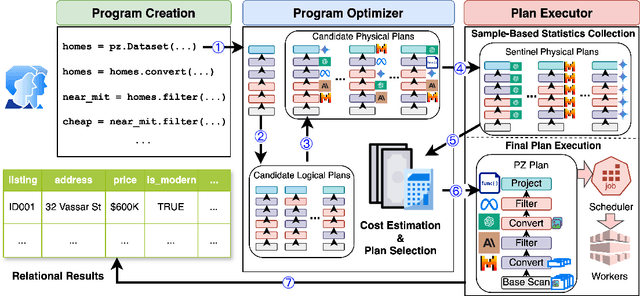
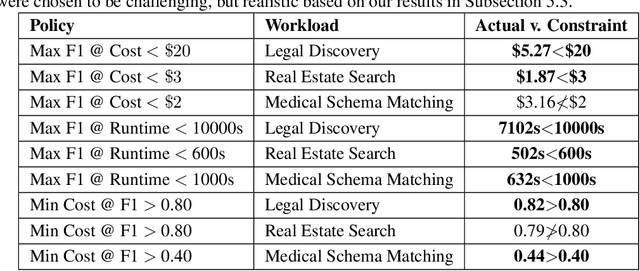
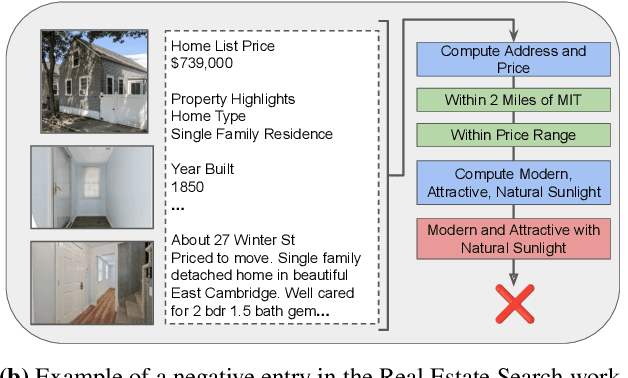
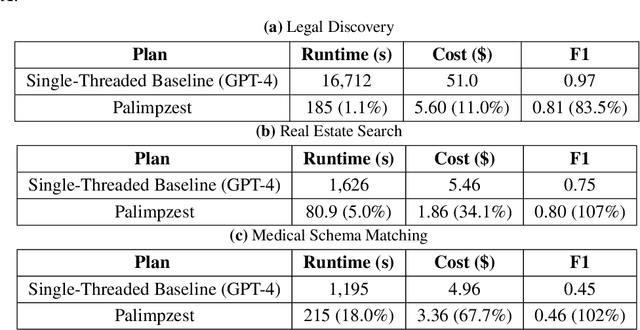
Abstract:Modern AI models provide the key to a long-standing dream: processing analytical queries about almost any kind of data. Until recently, it was difficult and expensive to extract facts from company documents, data from scientific papers, or insights from image and video corpora. Today's models can accomplish these tasks with high accuracy. However, a programmer who wants to answer a substantive AI-powered query must orchestrate large numbers of models, prompts, and data operations. For even a single query, the programmer has to make a vast number of decisions such as the choice of model, the right inference method, the most cost-effective inference hardware, the ideal prompt design, and so on. The optimal set of decisions can change as the query changes and as the rapidly-evolving technical landscape shifts. In this paper we present Palimpzest, a system that enables anyone to process AI-powered analytical queries simply by defining them in a declarative language. The system uses its cost optimization framework -- which explores the search space of AI models, prompting techniques, and related foundation model optimizations -- to implement the query with the best trade-offs between runtime, financial cost, and output data quality. We describe the workload of AI-powered analytics tasks, the optimization methods that Palimpzest uses, and the prototype system itself. We evaluate Palimpzest on tasks in Legal Discovery, Real Estate Search, and Medical Schema Matching. We show that even our simple prototype offers a range of appealing plans, including one that is 3.3x faster, 2.9x cheaper, and offers better data quality than the baseline method. With parallelism enabled, Palimpzest can produce plans with up to a 90.3x speedup at 9.1x lower cost relative to a single-threaded GPT-4 baseline, while obtaining an F1-score within 83.5% of the baseline. These require no additional work by the user.
PipeRAG: Fast Retrieval-Augmented Generation via Algorithm-System Co-design
Mar 08, 2024



Abstract:Retrieval-augmented generation (RAG) can enhance the generation quality of large language models (LLMs) by incorporating external token databases. However, retrievals from large databases can constitute a substantial portion of the overall generation time, particularly when retrievals are periodically performed to align the retrieved content with the latest states of generation. In this paper, we introduce PipeRAG, a novel algorithm-system co-design approach to reduce generation latency and enhance generation quality. PipeRAG integrates (1) pipeline parallelism to enable concurrent retrieval and generation processes, (2) flexible retrieval intervals to maximize the efficiency of pipeline parallelism, and (3) a performance model to automatically balance retrieval quality and latency based on the generation states and underlying hardware. Our evaluation shows that, by combining the three aforementioned methods, PipeRAG achieves up to 2.6$\times$ speedup in end-to-end generation latency while improving generation quality. These promising results showcase the effectiveness of co-designing algorithms with underlying systems, paving the way for the adoption of PipeRAG in future RAG systems.
Extract-Transform-Load for Video Streams
Oct 07, 2023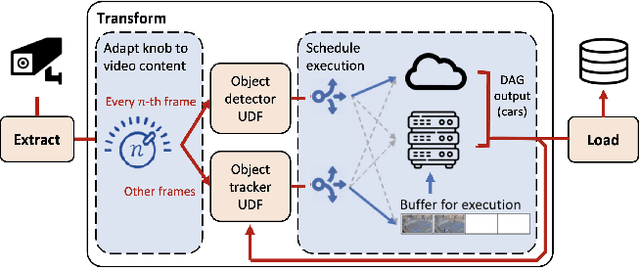

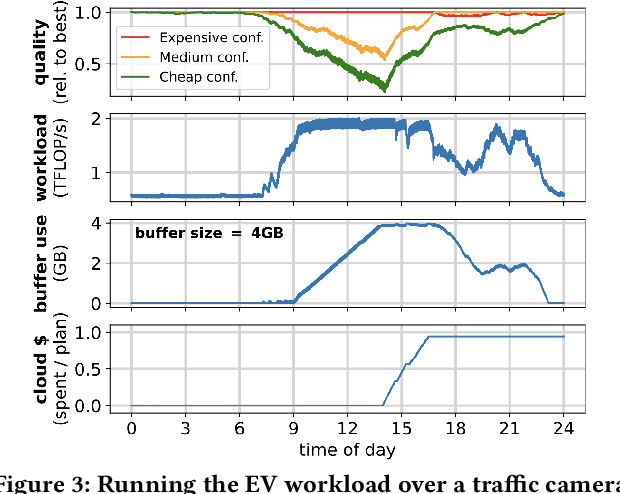

Abstract:Social media, self-driving cars, and traffic cameras produce video streams at large scales and cheap cost. However, storing and querying video at such scales is prohibitively expensive. We propose to treat large-scale video analytics as a data warehousing problem: Video is a format that is easy to produce but needs to be transformed into an application-specific format that is easy to query. Analogously, we define the problem of Video Extract-Transform-Load (V-ETL). V-ETL systems need to reduce the cost of running a user-defined V-ETL job while also giving throughput guarantees to keep up with the rate at which data is produced. We find that no current system sufficiently fulfills both needs and therefore propose Skyscraper, a system tailored to V-ETL. Skyscraper can execute arbitrary video ingestion pipelines and adaptively tunes them to reduce cost at minimal or no quality degradation, e.g., by adjusting sampling rates and resolutions to the ingested content. Skyscraper can hereby be provisioned with cheap on-premises compute and uses a combination of buffering and cloud bursting to deal with peaks in workload caused by expensive processing configurations. In our experiments, we find that Skyscraper significantly reduces the cost of V-ETL ingestion compared to adaptions of current SOTA systems, while at the same time giving robustness guarantees that these systems are lacking.
* 26 pages, 23 figures
SEED: Simple, Efficient, and Effective Data Management via Large Language Models
Oct 01, 2023Abstract:We introduce SEED, an LLM-centric system that allows users to easily create efficient, and effective data management applications. SEED comprises three main components: code generation, model generation, and augmented LLM query to address the challenges that LLM services are computationally and economically expensive and do not always work well on all cases for a given data management task. SEED addresses the expense challenge by localizing LLM computation as much as possible. This includes replacing most of LLM calls with local code, local models, and augmenting LLM queries with batching and data access tools, etc. To ensure effectiveness, SEED features a bunch of optimization techniques to enhance the localized solution and the LLM queries, including automatic code validation, code ensemble, model representatives selection, selective tool usages, etc. Moreover, with SEED users are able to easily construct a data management solution customized to their applications. It allows the users to configure each component and compose an execution pipeline in natural language. SEED then automatically compiles it into an executable program. We showcase the efficiency and effectiveness of SEED using diverse data management tasks such as data imputation, NL2SQL translation, etc., achieving state-of-the-art few-shot performance while significantly reducing the number of required LLM calls.
 Add to Chrome
Add to Chrome Add to Firefox
Add to Firefox Add to Edge
Add to Edge